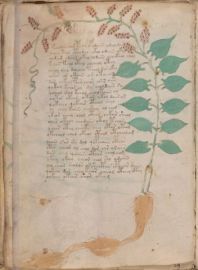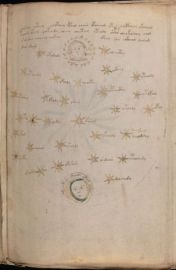



cumque in mea Bibliotheca Sphinx quaedam, Scripturae incognitorum characterum inutiliter occupasset locum, ...
Ex pictura herbarum, quarum plurimus est in Codice numerus, imaginum diversarum, Astrorum, aliarumque rerum, faciem chymicorum arcanorum referentium, conjicio totum esse medicinalem; (1)
Nearly 400 years ago, on 27 April 1639 the Prague citizen Georgius Barschius wrote the above lines in a letter to the learned Jesuit Athanasius Kircher in Rome. He explained that he owned a mysterious book that was written in an unknown script, and was profusely illustrated with pictures of plants, stars and arcane chemical secrets.
He wrote that he could not read it, and he was as confused as we are still today, because he owned
The Most Mysterious Manuscript in the World:
... to my web site about the Voynich Manuscript!
This manuscript (MS in the following) is named after Wilfrid Voynich, an antiquarian book dealer who acquired it in Italy, and presented it to the modern world in 1912. Already during his lifetime, the manuscript became famous because, despite its length of over 230 pages, its text could not be deciphered.

The manuscript passed through several hands, and is now preserved in the Beinecke Rare Book and Manuscript Library of Yale University, where it is catalogued as MS 408. It is a late medieval handwritten book, and even today the text cannot be understood. It now ranks among the most famous manuscripts in the world (2), and it is recognised as the main unsolved problem in the history of cryptography (3).
While nobody has been able to find an explanation for the text, the book just seems to be waiting for someone to achieve this. If you are interested in trying this, or also if you are just curious to find out more about this MS, do read on, because the purpose of this web site is to provide as much information about the Voynich MS as possible.
If you just heard or read that the MS has been solved, then rest assured:
The text of the Voynich MS has NOT YET been solved.
All of the many, many claims of people who state that they have found the solution, up to the date of this page (see at the bottom) have proven to be false. As soon as this changes, you will read about it here. If you believe that you have just found the solution, please don't just contact me, but go here first.
The Voynich MS is a genuine late medieval illustrated manuscript that was created somewhere in the first few decades of the 15th century. It is a small volume of some 16 x 22.5 cm, originally counting 116 folios. It is written on parchment made from calf skin, while the present cover is not original. The creator(s) is/are unknown, but five different scribes can be recognised. The place where it was created is equally unknown, but is presumed to be somewhere in Central Europe including (modern) Northern Italy. The illustrations are mostly unique to this manuscript. No illustration has been identified that is definitely a copy of an illustration in another manuscript.
The writing is unique to this manuscript. No other document using the same characters exists. The writing is not a standard cipher of the late middle ages (or early modern period). It cannot be translated into any known European language of the time by simply substituting the symbols one by one (4). Everyone who has tried to translate the text so far has failed (though not all have accepted this). While the MS is certainly genuine, it remains possible that the text has no meaning. There are many arguments, but no solid proof, either way.
The MS was almost certainly sold to emperor Rudolf II in Prague around the year 1600, and passed through various hands in Prague until it was sent to Athanasius Kircher in Rome in 1665. It seems to have stayed there, but there is no record after Kircher's death in 1680, and it was hidden shortly after 1870, until it was acquired by Voynich in 1912, under mysterious circumstances. The MS has been studied by the greatest code-breaking experts ever since the 1920's, but they did not find any solution. The antiquarian book dealer Hans P. Kraus donated the MS to the Beinecke Library in 1969.
The manuscript continues to attract people from all over the world, primarily because of the mystery of its unreadable text, but there is more to it. For some reason, it allows just about everyone to recognise something in it. It has something that causes so many people to believe that they can solve this mystery. Voynich once stated that the book would become more valuable as soon as it has been deciphered, but this is hardly true. Its mystery and its resistance to translation is what makes it special (5).
All of the above is presented here without evidence. This evidence may be found on this web site, and the remainder of this page presents its structure.
A the highest level, this web site consists of three areas:
The core section itself consists of the following topics:
There is a detailed Table of Contents of the core section and part of the reference section.
There is a second Table of Contents of the additional material.
There is a site map further explaining the structure of this site, and the various navigation tools.
 |
 |
 |
||
 |
 |
 |
 |
 |